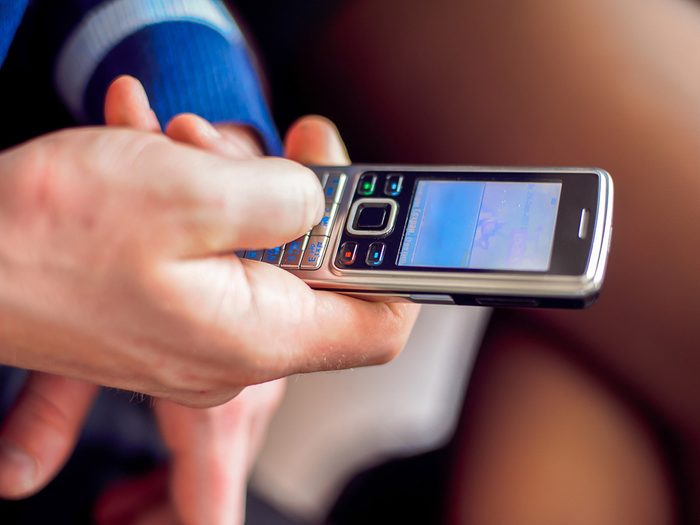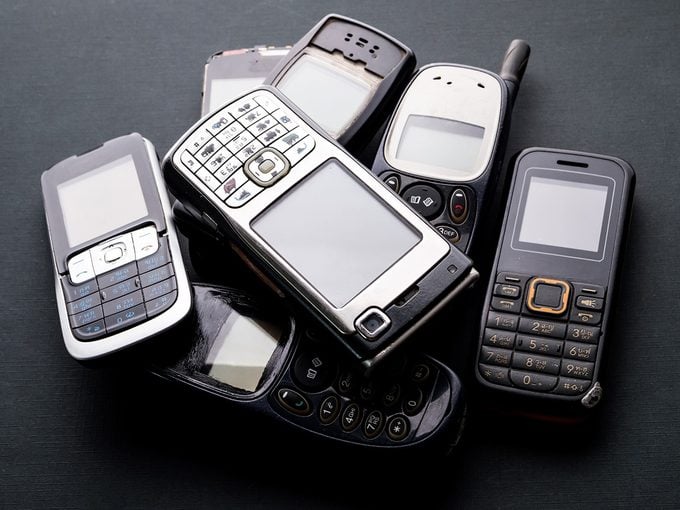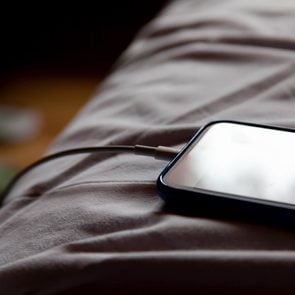5G is Coming. Will Your Phone Still Work?

Canadian telecom providers will soon “sunset” 3G networks in favour of faster 5G. Here’s what you need to know.
The storm seemed to come out of the blue. In the small cottage-country village of Cloyne, in eastern Ontario, residents started that sunny Saturday—May 21, 2022—in a festive mood, gathering outside the community hall for a trunk sale, barbecue and live music.
But by early afternoon, violent winds began to pick up as heavy rain fell. Some partygoers left and others scrambled into the town hall as a derecho—a fast-moving thunderstorm that causes widespread wind damage—ripped through town.
Late that morning, a series of emergency mobile smartphone alerts had been issued by Environment and Climate Change Canada, warning of a wall of wind and rain barrelling toward eastern Ontario from the southwest. But the shrill alarm tone and emergency text messages sent from Alert Ready, Canada’s emergency alert system, hadn’t reached many at the Cloyne gathering. While infrastructure upgrades have been underway since 2021, the most consistent access in the area comes from a 3G (third-generation) cellular network. “We didn’t get the message,” says township councillor Ken Hook.
No signal?
Like much of our daily life, Canada’s Alert Ready system operates on the assumption that Canadians have good cellular service—and these days, that means something better than 3G. To receive Alert Ready messages on your mobile phone (alerts are also broadcast over radio and television), you must have access to at least a 4G/LTE network (the current standard for data transmission on most smartphones) and have a cellphone that is compatible with that network—typically one that’s no more than six to nine years old.
While it’s easy enough (though not so cheap) to upgrade to a newer cellphone, your network access depends on where you live, with rural areas more likely to rely on 3G alone or a patchwork of 3G and 4G/LTE networks.
Now, that connection is at a crossroads: Over the next few years, Canada’s major telecommunications providers—Bell, Rogers and Telus—are expected to “sunset” the 20-year-old 3G infrastructure to save money and free up resources for newer, faster 5G networks. That means older cellphones will no longer work, and some remote communities could become cellular dead zones, even if they previously had service.
For Cloyne and other small communities that still have unreliable network connections—including Brooklyn, N.S., where Alert Ready messages warning of a flash flood failed to reach many residents in July 2023—being left off the emergency-alert list is just a taste of what could happen if cellular networks aren’t upgraded.
Stranded at home
It’s not just your cellphone connection that’s at risk. The shutdown could also affect any Canadian who has a home-security alarm, medical-alert device, vehicle SOS button or other device that still transmits data over 3G. Unless people upgrade their devices to newer models, they could suddenly stop working, leaving seniors, homeowners and drivers unable to contact loved ones or call for help in an emergency.
Once heralded as cutting-edge, 3G ushered in the smartphone revolution when Rogers and Apple launched the iPhone 3G in Canada in 2008, allowing users to access the internet on their mobile phones. Now, like its 1G and 2G predecessors, 3G is headed for the technology dustbin.
In the U.S., major American service providers T-Mobile, AT&T and Verizon finished “sunsetting” the last of their 3G networks at the end of 2022. Experts say Canada will be following suit. And while we don’t know exactly when, it’s essential that we get ready.

Our great digital divide
With its vast geography and unevenly distributed population, Canada’s “digital divide” is nothing new. While every province has at least 99.9 percent coverage for urban residents, that’s not the case for rural residents. And First Nations reserves have the lowest levels of 4G/LTE coverage, at less than 88 percent.
As of 2021, 46,000 Canadian households relied solely on 3G networks, while 76,000 had no connection at all, according to the United Nations Economic Commission for Europe. While telecommunications providers are building new towers, they’re more likely to focus on major cities and highly populated areas. That leaves the various levels of government to fill in the gaps.
In Nova Scotia, when four people died after being swept away during a flash flood in July 2023, politicians again voiced long-held concerns about cellular dead zones and an inability to contact emergency services. During a visit to an emergency command centre in Brooklyn, N.S., Deputy Prime Minister Chrystia Freeland said, “It’s not acceptable for people not to be able to get emergency alerts.” She then called on the Canadian Radio-television and Telecommunications Commission (CRTC) to address the issue.
To solve the problem, financial incentives must be offered to private carriers to expand up-to-date network infrastructure in sparsely populated areas, reports the Auditor General’s office. With a limited number of subscribers, telecommunications companies are reluctant to pay the high cost of leasing land, building new towers, hauling equipment and laying fibre-optic cable over vast expanses.
Recognizing that access to the internet is a basic utility—like electricity, water and heat—the CRTC aims to ensure high-speed internet access to 100 percent of Canadians by 2030. “[Internet and voice services] are an important part of Canada’s public safety infrastructure,” said CRTC chair Ian Scott in a 2022 press release. In 2016, the CRTC established the Broadband Fund, a $675-million, five-year commitment to improve high-speed internet and wireless services in underserved communities.
5G is faster and better
While satellite technology promises a tantalizing solution to the connectivity gap, offering fast and dependable (but expensive) internet in previously underserved rural areas, it doesn’t offer cellular service—at least not yet. (Starlink, a subsidiary of SpaceX, owned by Tesla billionaire Elon Musk, is one example.)
Meanwhile, in major cities across the country, cutting-edge 5G networks are already widely used. And while 4G/LTE is expected to be around for a while, 5G is the future. It can deliver download speeds 10 times faster than 4G/LTE and more than 50 times faster than 3G. The increased capacity and lower latency—the time it takes for a message to be sent and received—allow users to stream high-definition video on their phones and could enable self-driving cars, improve traffic safety in cities and allow for advanced health-care diagnostics.
So why can’t 3G and 5G coexist? The reason is that the radio-frequency spectrum—which the government licenses to telecommunications providers—is the range of invisible electromagnetic airwaves that transmit all forms of wireless communication, including your local radio station, your cellphone and your home Wi-Fi. And there is only so much of that spectrum available.
Plus, because of the new networks’ higher speed and data capabilities, they require more bandwidth on the spectrum. That means that the bandwidth used by 3G technology may need to be freed up, as has been done in the U.S.
It doesn’t come cheap
Also, maintaining 3G, 4G/LTE and 5G networks concurrently is very expensive for carriers, especially over a huge geographic area like Canada, says Mai Vu, professor of electrical engineering at Tufts University in Massachusetts. “Because 3G uses different equipment and algorithms, providers have to run two entirely separate systems—one for 3G and one for 4G and 5G,” says Vu.
The costs to maintain towers and hardware, power the system, pay technicians and renew spectrum licenses can be onerous. “With the number of 3G users getting smaller and smaller, shutting down the network is really a business and economic decision,” Vu says.
You can find out what network coverage your location has by going to your service provider’s website and finding it on their coverage map. The farther you are from an urban centre or a major highway, the more likely you are to be using 3G. You’ll often see it as “H” or “HSPA” in your phone’s status bar, which stands for high-speed packet access, another name for 3G.
At the time of this writing, Bell, Rogers and Telus would not confirm an exact date for when the 3G shutdown would begin, although some experts believe it will be by the end of 2025.
Crossed signals
In the U.S., the now complete 3G shutdown will also affect travellers to that country. Canadians with older phones that are only compatible with 3G (you can check yours here) will find they can no longer access the internet, send texts or make calls—including 911—while travelling south of the border.
How the 3G sunset played out in the U.S. offers insight into what we might expect on this side of the border. By the end of 2022, 2.3 million U.S. mobile accounts had been disconnected. Although U.S. carriers claimed they’d been reminding customers for years to upgrade their devices, seniors and other users of older phones tend to be less tech savvy and often dismiss messages and calls from wireless carriers as marketing spam.

What needs an upgrade?
Even if you live in an area with reliable high-speed network access, you’ll need to make sure your cellphone and other devices are compatible. Things like medical devices, smart meters for electricity, water and gas, and GPS systems may still operate on slower 3G. Upgrading them usually involves a change of hardware, not just a simple software update. Manufacturers should proactively reach out to customers to offer an upgrade, but in some cases, the onus may fall on consumers themselves. For the less tech-savvy among us, we may not know our devices are obsolete until it’s too late.
In Canada, major carriers are already offering customers free upgrades of devices that will soon be out of date. Telus, makers of the LivingWell Companion emergency-response device, has been telling customers since mid-2022 about the need to upgrade to a 4G or higher cellular-enabled model. Available as a pendant or smartwatch, the device can detect falls and automatically dial a 24-hour operator for help, providing a valuable sense of security and independence to seniors living alone.
Last year, Telus identified almost 2,000 customers who were still using older models of the pendant and contacted them via email, phone and mail, says Chris Engst, Telus Health’s vice-president of consumer health.
“Almost all of the customers we reached out to accepted the free upgrade, which we sent out to them by mail, with support over the phone,” he says. “It was especially important to make the process seamless.” According to the Public Health Agency of Canada, 20 to 30 percent of Canadians over 65 have a serious fall each year.
Security issues
Owners of older home-security systems, which normally connect to the alarm company’s call centre via landline, should check if their hardware uses a 3G backup cellular communicator to contact a monitoring centre in the event of a power failure or an intruder cutting phone lines. If you haven’t been contacted by your home-security supplier, be sure to get in touch to schedule an appointment with a technician.
You may also need to get your car’s software and/or hardware upgraded. At least 150 common car models—manufactured from 2010 to as late as 2021—come equipped with an SOS button or crash-notification system that dials emergency services via 3G. If you drive one of these vehicles—such as the Volkswagen Golf, Hyundai Elantra or Honda Accord—you’ll need to contact your dealer to find out what fixes are available and if they can offer you refunds or incentives.
Old dogs, new tricks
If you use an older smartphone and are hesitant to trade it in—or you do not own a smartphone—you’re not alone. HelpAge Canada, a non-profit that advocates for more inclusion and quality of life for older adults, offers “Dig-It” digital-literacy workshops at community centres and retirement homes. Participants can explore tablets and smartphones in a supportive environment, where seniors learn from each other about how to manage their devices and stay safe online.
“There’s sometimes a confidence barrier, when people assume they’re too old to learn anything new,” says Raza Mirza, director of national partnerships and knowledge mobilization at HelpAge Canada. “But older adults have no lack of motivation to use technology once they get comfortable with it.”
If a smartphone seems too overwhelming, many carriers offer low-cost talk-and-text “dumbphones”—like the TCL Flip or the ZTE Cymbal 2—that are even making a comeback among young people seeking to unplug from social media. But unlike their early-2000s ancestors, these new simpler phones are 4G/LTE-enabled, so you won’t have to worry about being sunsetted anytime soon.
Closing the digital divide
Slowly, Canada’s Telecom giants are working with governments to close the digital divide, town by town, road by road, with the goal of giving all Canadians online access by 2030.
Near Cloyne, the future is already looking brighter. A non-profit called the Eastern Ontario Regional Network (EORN) recently secured $300 million in funding to improve cellular service in the region, thanks to a partnership with various levels of government and Rogers, the provider that was selected through a competitive bidding process. So far, more than 300 towers have been upgraded to support 5G, and 44 new towers have been built across EORN’s 50,000-square-kilometre territory.
“Besides economic development and tourism, our work is also important for public safety,” says Jason St. Pierre, EORN’s CEO. “Not only will people be able to call 911, but paramedics will be able to triage with emergency-room physicians on their way to the hospital over video conference.”
Residents in Cloyne hope the missed alerts, dropped calls and dead zones will soon be things of the past. “It’s been a fight for years and years,” says councillor Hook. “I’m glad we’re finally getting the connection we need.”
But it’s up to each of us to make sure we’ll be able to use the latest communications networks.
Do you need a new phone?
All iPhone models 4S and older are only 3G compatible, as are the first Google Pixel and all Samsung Galaxy models older than S5. Older cell-enabled tablets and e-readers, such as the first and second iPad and early Kindle models (up to and including the 2010 model), also rely on 3G to download data.
You can check which networks your device has access to by opening “Settings,” then “Network Settings” and “Mobile Network.” If you don’t see 4G/LTE or 5G in the drop-down menu of networks, chances are your phone is only 3G capable.
You can also dial *#06# to display your phone’s 15-digit international mobile equipment identity (IMEI) number, then enter it here to see your phone’s specifications, including networks.
Next, check out this story about a woman whose cellphone saved her during a “snownado.”






